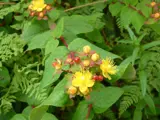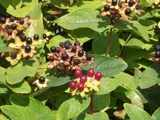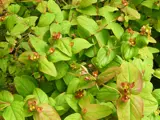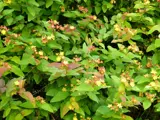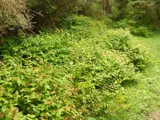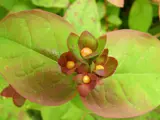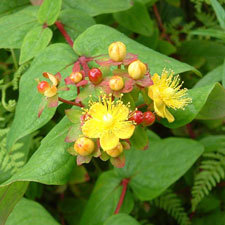 Tutsan
Tutsan
Common name: Tutsan; Sweet amber
Botanical name: Hypericum androsaemum
Management programme: Advisory
Originally from southern Europe to Iran and introduced to New Zealand as a garden ornamental. It was naturalised in 1892.
Why is it a pest?
- Produces many long-lived easily dispersed seeds.
- It is unpalatable to stock who will not eat it. This allows for the plants to reduce available pasture for grazing as they spread.
- Tolerates semi shade, hot and cold temperatures and high rainfall.
- Spread by birds and possibly possums. Seeds also spread in soil and by water and on machinery.
- Establishes and spreads very easily.
Where is it found?
Tutsan is scattered in the Bay of Plenty. It prefers high rainfall areas and is found in disturbed forest and shrubland areas, roadsides, stream beds, riparian margins, tussockland, bare land.
What does it look like?
- Small semi- evergreen shrub up to 1.5m tall. Stems are woody.
- Leaves are oval up to 100mm, opposite and are pale green on the top and bluish-green underneath and have a waxy coat.
- Leaves turn red-yellow in autumn and smell of curry when crushed.
- Has pale yellow flowers in bunches at the end of each branch.
- Flowers appear in November and last through to February.
- Has round fruit up to 10mm that are red turning to black that appear after flowering. If you open the seed pod and rub the seeds in your hand it will feel dusty.
What are the rules?
Advisory
Council does not enforce the control of advisory species. It is landowner/occupier responsibility to manage these pests. Council may provide advice on how to manage or control advisory species if required.
How do you get rid of it?
- Dig out small infestations making sure to get all the rhizomes.
- Cut down and stump treat with herbicide in the spring-summer.
- Overall spray Nov-Jan with herbicide.
Occasionally re-sprouts from roots after a poor spray kill. Dispose of any plant material at the refuse station in general waste.
CAUTION: When using any herbicide or pesticide, PLEASE READ THE LABEL THOROUGHLY to ensure that all instructions and directions for the purchase, use and storage of the product, are followed and adhered to.
Read more on pest control advice, information and regulations.
Images

